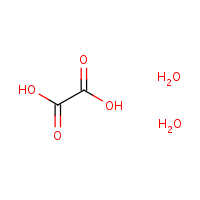Oxalic acid dihydrate
Agent Name
Oxalic acid dihydrate
CAS Number
6153-56-6
Formula
C2-H2-O4.2H2-O
Major Category
Other Classes

Synonyms
Ethanedioic acid, dihydrate; [ChemIDplus] Ethanedioic acid dihydrate; [ICSC] UN3261
Category
Organic Acids
Description
Colorless solid; [ICSC] Colorless hygroscopic crystals; [Sigma-Aldrich MSDS]
Sources/Uses
Used in calico printing and dyeing, bleaching straw hats and leather, cleaning wood and metals, purifying methanol,
decolorizing crude glycerol, stabilizing hydrocyanic acid, removing paint, and removing stains; Also used in ceramics and pigments, in veterinary hemostatic solutions, in blood specimen anticoagulants, and in other industries (paper, photography, engraving, and rubber manufacturing); [Merck Index] Permitted for use as an inert ingredient in non-food pesticide products; [EPA]
Comments
Causes burns; Ingestion may have effects on calcium balance; Repeated or prolonged exposure may cause kidney stones; [ICSC] Causes burns; Inhalation may cause corrosive injuries to upper respiratory tract and lungs; Harmful by ingestion and skin absorption; May have teratogenic effects; Targets the kidney, nerves, blood, and eyes; [Sigma-Aldrich MSDS] See "Oxalic acid."
Biomedical References
Exposure Assessment
TLV (ACGIH)
1 mg/m3
STEL (ACGIH)
2 mg/m3
PEL (OSHA)
1 mg/m3
Explanatory Notes
The Guide in the Emergency Response Guidebook is for "Corrosive solid, acidic, organic, n.o.s."
Adverse Effects
Toxic Pneumonitis
Yes
Dermatotoxin
Skin burns
Diseases, Processes, and Activities Linked to This Agent
Processes
Industrial Processes with risk of exposure: